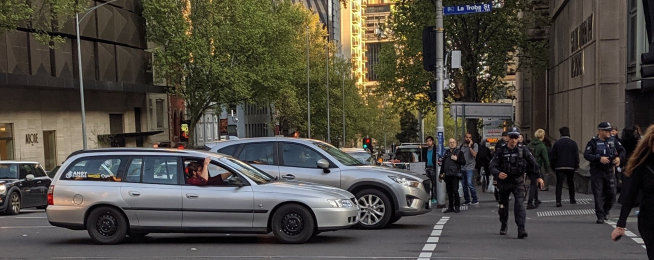The Victorian government will get tough with drivers who nudge into or completely block intersections.
The intersection blockers are the bane of bike riders everywhere, greatly increasing the risk of collisions.
As bike riders generally have a free run down the kerbside lane right to the intersection, when some drongo in a car decides to sneak in or cross when there is no exit space on the other side, the outcome can be perilous.
The new offensive firstly will involve a trial with six busy intersections across Melbourne painted yellow.
Prominent signage, in conjunction with a large yellow box painted across the intersection and marked with a single X, will advise motorists to keep clear.
We have painted yellow boxes across some of Melbourne’s busiest intersections, in a trial to reduce the number of cars blocking the intersection.
Blocking the intersection creates a safety hazard for all road users.
By keeping the yellow box clear, everyone gets a better run! pic.twitter.com/FQVvM7vTmH— Ben Carroll (@BenCarrollMP) June 30, 2021
During the trial, the Victorian Government will collect data to determine how often intersections are blocked. It will also provide information about the patterns of traffic flow, delays, and test the overall effectiveness of the yellow box and signage.
The next phase of the trial which will commence in September, will see road safety cameras installed to identify offenders and determine how often offences are occurring. During the trial, motorists will receive a warning.
Blocking an intersection is already and offence. Under Victorian road rule 128, ‘A driver must not enter an intersection or crossing when the intersection or crossing is blocked or the road beyond the intersection or crossing is blocked.
Seriously? #Rule128 pic.twitter.com/U4LsZUNitY
— Daniel Bowen (@danielbowen) October 13, 2019
Current penalties for blocking an intersection attract three demerit points and a $165 fine.
The intersections included in the trial have been identified as ones that are regularly blocked, causing gridlock and delaying trams and buses during peak times.
The six intersections involved in the trial are Swan Street/Burnley Street, Monash Freeway/Warrigal Road, High Street/Malvern Road, Williamsons Road/Foote Street, Power Street/Riversdale Road and Mickleham Road/Tullamarine Freeway Interchange.
Minister for Roads and Road Safety Ben Carroll said: “Don’t block intersections. It’s as simple as that. You’ll get to where you need to go in less time, and it will make the network safer for everyone.”
Image credit: @jessemcnelis
Become our friend
Find out more about Bicycle Network and support us in making it easier for people to ride bikes.


